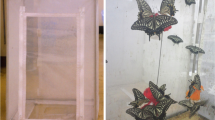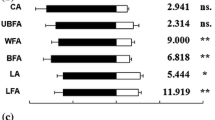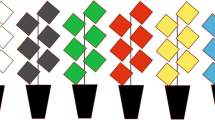Abstract
The electroantennogram responses (EAGs) of Macrolophus melanotoma and Macrolophus pygmaeus (Hemiptera: Miridae) exposed to volatile compounds (VOCs) of host and non-host plants were compared. The VOCs were identified by gas chromatography. Hosts and non-hosts eliciting similar EAGs were tested in olfactory assays against plants without a significant EAGs for the two Macrolophus species. No characteristic VOC profile was found for hosts and non-hosts. Terpenes predominated in many hosts and carboxylic acids in non-hosts, but no specific VOCs were characteristic of host plants. Significant EAGs (maximum deflection values in mV) were recorded in plants with very different VOC profiles, both hosts and non-hosts. The EAGs were higher for M. melanotoma than for M. pygmaeus, and were higher for males than for females. In M. melanotoma the EAGs were greater with hosts than with non-hosts, but they were similar in M. pygmaeus. The EAGs were correlated with the concentrations of sesquiterpenes and alcohols in both species. In olfactory assays, M. melanotoma and M. pygmaeus preferred their respective hosts, but they did not discriminate between non-host with and without significant EAGs. According to the results, Macrolophus species are expected to rely on ubiquitous VOCs for the identification of their hosts. The variation in the EAGs between M. melanotoma and M. pygmaeus is attributed to the variation in the proportions of olfactory receptor neurones with different sensitivity to VOCs (e.g. sesquiterpenes). Host plant selection is discussed in the light of the perception of VOCs and the processing of information by the central nervous system.




Similar content being viewed by others
References
Alomar Ó, Albajes R (1996) Greenhouse whitefly (Homoptera: Aleyrodidae) predation and tomato fruit injury by the zoophytophagous predator Dicyphus tamaninii (Heteroptera-Miridae). In: Alomar Ó, Wiedenmann RN (eds) Zoophytophagous Heteroptera: implications for life history and Integrated Pest Management. Entomological Society of America, Lanham, pp 155–177
Alomar Ó, Castañe C, Gabarra R, Albajes R (1994) Mirid bugs for biological control: identification, survey in non-cultivated winter plants, and colonization of tomato fields. IOBC WPRS Bull 17:217–223
Alomar Ó, Gabarra R, González O, Arnó J (2006) Selection of insectary plants for ecological infrastructure in Mediterranean vegetable crops. IOBC WPRS Bull 29:5–8
Bernays EA, Chapman RF (1994) Host-plant selection by phytophagous insects. Chapman & Hall, New York
Bernays E, Graham M (1988) On the evolution of host specificity in phytophagous arthropods. Ecology 69:886–892
Bruce TJA, Pickett JA (2011) Perception of plant volatile blends by herbivorous insects - finding the right mix. Phytochemistry 72:1605–1611
Bruce TJA, Wadhams LJ, Woodcock CM (2005) Insect host location: a volatile situation. Trends Plant Sci 10:269–274
Calvo J, Blockmans K, Stansly PA, Urbaneja A (2009) Predation by Nesidiocoris tenuis on Bemisia tabaci and injury to tomato. Biocontrol 54:237–246
Cassis G (1986) A systematic study of the subfamily Dicyphinae (Heteroptera, Miridae), Ph.D. Thesis, Oregon State University, University Microfilms International, Ann Arbor, USA
Cassis G, Schuh RT (2012) Systematics, biodiversity, biogeography, and host associations of the Miridae (Insecta: Hemiptera: Heteroptera: Cimicomorpha). Annu Rev Entomol 57:377–404
Castañe C, Agustí J, Gabarra R, Riudavets J, Comas J, Alomar Ó (2013) Taxonomic identification of Macrolophus melanotoma based on morphometry and molecular markers. Bull Entomol Res 103:204–215
Chen H, Zhao Y, Kang L (2004) Comparison of the olfactory sensitivity of two sympatric steppe grasshopper species (Orthoptera: Acrididae) to plant volatile compounds. Sci China Ser C Life Sci 47(2):115–123
Christensen T, Hildebrand JG (2002) Pheromonal and host-odor processing in the insect antennal lobe: how different? Curr Opin Neurobiol 12:393–399
Couladis M, Chinou IB, Tzakou O, Loukis A (2002) Composition and antimicrobial activity of the essential oil of Ballota pseudodictamnus (L.) Bentham. Phytother Res 16:723–726
Crawley MJ (2007) The R book. Wiley, Chichester
Development Core Team R (2008) A language and environment for statistical computing. R Foundation for Statistical Computing, Vienna
Dicke M (1994) Local and systemic production of volatile herbivore-induced terpenoids - their role in plant-carnivore mutualism. J Plant Physiol 143:465–472
Dicke M (2000) Chemical ecology of host-plant selection by herbivorous arthropods: a multitrophic perspective. Biochem Syst Ecol 28:601–617
Dicke M, Loon JJA (2000) Multitrophic effects of herbivore-induced plant volatiles in an evolutionary context. Entomol Exp Appl 97:237–249
Farhat MB, Jordan MJ, Chaouech-Hamada R, Landoulsi A, Sotomayor JA (2009) Variations in essential oil, phenolic compounds, and antioxidant activity of Tunisian cultivated Salvia officinalis L. J Agr Food Chem 57:10349–10356
Fraser AM, Mechaber WL, Hildebrand JG (2003) Electroantennographic and behavioral responses of the sphinx moth Manduca sexta to host plant headspace volatiles. J Chem Ecol 29(8):1813–1833
Frati F, Salerno G, Conti E, Bin F (2008) Role of the plant-conspecific complex in host location and intra-specific communication of Lygus rugulipennis. Physiol Entomol 33:129–137
Fuyama Y (1978) Behavior genetics of olfactory responses in Drosophila. II. Odorant-specific variant in a natural-population of Drosophila melanogaster. Behav Genet 8:399–414
Gazim ZC, Ferreira GA, Rezende CM, Nakamura CV, Dias Filho BP, Cortez DAG (2007) Identificação dos constituintes químicos da fração volátil da Calendula officinalis produzida no Paraná. Hortic Bras 25:118–121
Ginzel MD, Hanks LM (2005) Role of host plant volatiles in mate location for three species of longhorned beetles. J Chem Ecol 31:213–217
Goula M (1989) Catàleg dels Miridae (Heteroptera) del massís del Garraf. Sessió Conjunta d’Entomologia ICHN-SCL 5:67–76
Goula M, Alomar Ó (1994) Miridos (Heteroptera: Miridae) de interés en el control integrado de plagas en tomate. Guía para su identificación. Boletín de Sanidad Vegetal, Plagas 20:131–143
Groot AT, Timmer R, Gort G, Lelyveld GP, Drijfhout FP, Van Beek TA, Visser JH (1999) Sex-related perception of insect and plant volatiles in Lygocoris pabulinus. J Chem Ecol 25:2357–2371
Guerrieri F, Schubert M, Sandoz JC, Giurfa M (2005) Perceptual and neural olfactory similarity in honeybees. PLoS Biol 3:718–732
Hardie J, Visser JH, Piron PGM (1995) Peripheral odour perception by adult aphid forms with the same genotype but different host-plant preferences. J Insect Physiol 41:91–97
Ingegno BL (2011) Distribution and bioethology of generalist Dicyphine predators (Hemiptera: Miridae), Ph.D. Thesis, University of Torino, Italy
Ingegno BL, Goula M, Navone P, Tavella L (2008) Distribution and host plants of the genus Dicyphus in the Alpine valleys of NW Italy. Bull Insectol 61:139–140
Ingegno BL, Pansa MG, Tavella L (2011) Plant preference in the zoophytophagous generalist predator Macrolophus pygmaeus (Heteroptera: Miridae). Biol Control 58:174–181
Ingegno BL, Ferracini C, Gallinotti D, Alma A, Tavella L (2013) Evaluation of the effectiveness of Dicyphus errans (Wolff) as predator of Tuta absoluta (Meyrick). Biol Control 67:246–252
Lacey ES, Ginzel MD, Millar JG, Hanks LM (2004) Male-produced aggregation pheromone of the cerambycid beetle Neoclytus acuminatus acuminatus. J Chem Ecol 30:1493–1507
Lins JJC, van Loon JJ, Bueno VH, Lucas-Barbosa D, Dicke M, van Lenteren JC (2014) Response of the zoophytophagous predators Macrolophus pygmaeus and Nesidiocoris tenuis to volatiles of uninfested plants and to plants infested by prey or conspecifics. BioControl 59:707–718
Luning PA, De Rijk T, Wichers HJ, Roozen JP (1994) Gas chromatography, mass spectrometry, and sniffing port analyses of volatile compounds of fresh bell peppers (Capsicum annuum) at different ripening stages. J Agric Food Chem 42(4):977–983
Lykouressis D, Perdikis DC, Tsagarakis A (2000) Polyphagous mirids in Greece: host plants and abundance in traps placed in some crops. Boll Lab Entomol Agrar “Filippo Silvestri” 56:57–68
Marongiu B, Piras A, Pani F, Porcedda S, Ballero M (2003) Extraction, separation and isolation of essential oils from natural matrices by supercritical CO2. Flavour Fragr J 18:505–509
Martinez-Cascales JI, Cenis JL, Cassis G, Sanchez JA (2006) Species identity of Macrolophus melanotoma (Costa 1853) and Macrolophus pygmaeus (Rambur 1839) (Insecta: Heteroptera: Miridae) based on morphological and molecular data and bionomic implications. Insect Syst Evol 37:385–404
Moayeri HRS, Ashouri A, Brodsgaard HF, Enkegaard A (2006a) Odour-mediated preference and prey preference of Macrolophus caliginosus between spider mites and green peach aphids. J Appl Entomol 130:504–508
Moayeri HRS, Ashouri A, Brodsgaard HF, Enkegaard A (2006b) Odour-mediated responses of a predatory mirid bug and its prey, the two-spotted spider mite. Exp Appl Acarol 40:27–36
Moayeri HRS, Ashouri A, Brodsgaard HF, Enkegaard A (2007a) Males of the predatory mirid bug Macrolophus caliginosus exploit plant volatiles induced by conspecifics as a sexual synomone. Entomol Exp Appl 123:49–55
Moayeri HRS, Ashouri A, Poll L, Enkegaard A (2007b) Olfactory response of a predatory mirid to herbivore induced plant volatiles: multiple herbivory vs. single herbivory (vol 131, pg 326, 2007). J Appl Entomol 131:504
Ogundajo AL, Oladosu IA, Ogunwande IA, Flamini G, Owolabi MS (2013) Study on the volatile constituents of Solanum nigrum var. virginicum L. from Nigeria. Asian J Plant Sci Res 3(1):94–98
Paolini J, Tomi P, Bernardini AF, Bradesi P, Casanova J, Kaloustian J (2008) Detailed analysis of the essential oil from Cistus albidus L. by combination of GC/RI, GC/MS and 13C-NMR spectroscopy. Nat Prod Res 22(14):1270–1278
Park KC, Hardie J (1998) An improved aphid electroantennogram. J Insect Physiol 44:919–928
Perdikis DC, Margaritopoulos JT, Stamatis C, Mamuris Z, Lykouressis DP, Tsitsipis JA, Pekas A (2003) Discrimination of the closely related biocontrol agents Macrolophus melanotoma (Hemiptera: Miridae) and M. pygmaeus using mitochondrial DNA analysis. Bull Entomol Res 93:507–514
Perdikis D, Favasa C, Lykouressis D, Fantinou A (2007) Ecological relationships between non-cultivated plants and insect predators in agroecosystems: the case of Dittrichia viscosa (Asteraceae) and Macrolophus melanotoma (Hemiptera: Miridae). Acta Oecol 31:299–306
Perdikis DC, Kapaxidi E, Papadoulis G (2008) Biological control of insect and mite pests in greenhouse solanaceous crops. Eur J Plant Sci and Biotech 2:125–144
Ryan MF (2002) Insect chemoreception. Fundamental and applied. Kluwer Academic Publishers, Dordrecht
Sanchez JA (2008) Zoophytophagy in the plantbug Nesidiocoris tenuis. Agric For Entomol 10:75–80
Sanchez JA (2009) Density thresholds for Nesidiocoris tenuis (Heteroptera: Miridae) in tomato crops. Biol Control 51:493–498
Sanchez JA, Martinez-Cascales JI, Lacasa A (2003) Abundance and wild host plants of predator mirids (Heteroptera: Miridae) in horticultural crops in the Southeast of Spain. IOBC WPRS Bull 26:147–151
Sanchez JA, Gillespie DR, McGregor RR (2004) Plant preference in relation to life history traits in the zoophytophagous predator Dicyphus hesperus. Entomol Exp Appl 112:7–19
Sanchez JA, Martinez-Cascales JI, Cassis G (2006a) Description of a new species of Dicyphus Fieber (Insecta: Heteroptera: Miridae) from Portugal based on morphological and molecular data. Insect Syst Evol 37:281–300
Sanchez JA, Pino-Perez M, del Davó M, Martinez-Cascales JI, Lacasa A (2006b) Zoophytophagy of the plantbug Nesidiocoris tenuis in tomato crops in southeast Spain. IOBC WPRS Bull 29:243–248
Sanchez JA, La Spina MA, Perera OP (2012) Analysis of the population structure of Macrolophus pygmaeus (Rambur) (Hemiptera: Miridae) in the Palaearctic region using microsatellite markers. Ecol Evol 2(12):3145–3159
Sanchez JA, del Amor FM, Flores P, López-Gallego E (2015) Nutritional variations at Nesidiocoris tenuis feeding sites and reciprocal interactions between the mirid and tomato plants. J Appl Entomol. doi:10.1111/jen.12246
Sasso R, Iodice L, Woodcock CM, Pickett JA, Guerrieri E (2009) Electrophysiological and behavioural responses of Aphidius ervi (Hymenoptera: Braconidae) to tomato plant volatiles. Chemoecology 19(4):195–201
Schuh RT, Slater JA (1995) True bugs of the world. Cornell University Press, Ithaca, New York
Silbering AF, Okada R, Ito K, Galizia CG (2008) Olfactory information processing in the Drosophila antennal lobe: anything goes? J Neurosci 28:13075–13087
Smith L, Beck JJ (2013) Effect of mechanical damage on emission of volatile organic compounds from plant leaves and implications for evaluation of host plant specificity of prospective biological control agents of weeds. Biocontrol Sci Tech 23(8):880–907
Sun X, Liu Z, Zhang A, Dong HB, Zeng FF, Pan XY, Wang Y, Wang MQ (2014) Electrophysiological responses of the rice leaffolder, Cnaphalocrocis medinalis, to rice plant volatiles. J Insect Sci 14(1):70
Syntech (2004) Electroantennography: a practical introduction. Hilversum; Netherlands http://www.syntech.nl/manuals/EAGpract.pdf
Tavella L, Goula M (2001) Dicyphini collected in horticultural areas of north-western Italy (Heteroptera Miridae). Boll Zool Agric Bach 33(1):93–102
Tholl D, Boland W, Hansel A, Loreto F, Röse US, Schnitzler JP (2006) Practical approaches to plant volatile analysis. Plant J 45(4):540–560
Tohuara K, Vosshall LB (2009) Sensing odorants and pheromones with chemosensory receptors. Ann Rev Physiol 71:307–332
Toshova TB, Velchev DI, Subchev MA, Tóth M, Vuts J, Pickett JA, Dewhirst SY (2010) Electrophysiological responses and field attraction of the grey corn weevil, Tanymecus (Episomecus) dilaticollis Gyllenhal (Coleoptera: Curculionidae) to synthetic plant volatiles. Chemoecology 20(3):199–206
Visser JH (1986) Host odor perception in phytophagous insects. Ann Rev Entomol 31:121–144
Webster B, Bruce T, Dufour S, Birkemeyer C, Birkett M, Hardie J, Pickett J (2008) Identification of volatile compounds used in host location by the black bean aphid, Aphis fabae. J Chem Ecol 34:1153–1161
Webster B, Gezan S, Bruce T, Hardie J, Pickett J (2010) Between plant and diurnal variation in quantities and ratios of volatile compounds emitted by Vicia faba plants. Phytochemistry 71:81–89
Wheeler AG Jr (2001) Biology of the plant bugs (Hemiptera: Miridae). Cornell University Press, Ithaca, New York
Wohlers P, Tjallingii WF (1983) Electroantennogram response of aphids to the alarm pheromone (E)-b-farnesene. Entomol Exp Appl 33:79–82
Acknowledgments
Juan Antonio Sánchez was awarded grants by the Ministerio de Ciencia e Innovación (Ramón y Cajal program) and the European Social Fund. Michelangelo La Spina received grants from the INIA. This work was funded in part by the research project PO07-007 (FEDER). We thank two anonymous reviewers for their inspiring comments.
Author information
Authors and Affiliations
Corresponding author
Electronic supplementary material
Below is the link to the electronic supplementary material.
ESM 1
(TXT 13 kb)
Rights and permissions
About this article
Cite this article
Ingegno, B.L., La-Spina, M., Jordan, M.J. et al. Host Plant Perception and Selection in the Sibling Species Macrolophus melanotoma and Macrolophus pygmaeus (Hemiptera: Miridae). J Insect Behav 29, 117–142 (2016). https://doi.org/10.1007/s10905-016-9549-1
Revised:
Accepted:
Published:
Issue Date:
DOI: https://doi.org/10.1007/s10905-016-9549-1




